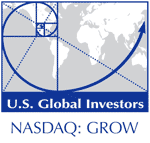"Wisdom of Crowds"
helps explain gold's price climb
Frank E. Holmes
Feb 1, 2008
All around the world, investors
believe in gold.
If you ask them why, you will
get a number of explanations and a level of conviction that has
endured despite opinions of many "experts" that gold
was overpriced at $500, then at $600, and so on until it reached
and passed $900.
It reminds me of an enlightening
book I read a few years ago called "The Wisdom of Crowds."
The book's basic premise is that "large groups of people
are smarter than an elite few."
Crowd wisdom is not to be confused
with "groupthink," in which members of a group prize
consensus and to get it, they suppress any contrary viewpoints
to avoid conflict. Groupthink often leads to ill-considered decisions.
 Source: streettracksgoldshares.com
Source: streettracksgoldshares.com
The streetTRACKS gold ETF chart
above shows the amazing growth that the gold ETFs were seeing
even before this year's derivatives and subprime debt disaster
that wiped out hedge funds and mortgage brokers, and dealt a
harsh blow to the earnings of major banks and brokerages.
The "wise crowd"
around the world - institutional and individual investors - has
been buying gold as a safe haven from currency risks and the
trillions of dollars invested in derivatives, and as a way to
recycle petrodollars.
European central bankers selling
so much of their gold at low prices is an example of groupthink,
as is the media's reluctance to accept gold as an asset class.
When I'm asked to talk about gold on TV, the questions usually
come from the perspective that gold has gone up and now it's
time for it to fall.
Back in the 1800s, Charles
Mackay wrote a book called "Extraordinary Popular Delusions
and the Madness of Crowds," in which he discusses Europe's
famous tulip frenzy in the 1600s (one bulb sold in Holland for
40 times the country's average family income) and other irrational
market behavior that creates speculative bubbles.
Despite the assertions of some,
today's gold is not the tulip of 400 years ago. While there are
many who believe in gold, not everyone is believing and buying.
What we're seeing in the market is not a bubble-blowing frenzy
fueled by crowd madness. Below is Kitco's chart of gold in 1980
- in January of that year, the price went up 40 percent in seven
trading days to its peak and over the next five days nearly all
of that gain was lost. Now that was a bubble.

Back to "The Wisdom
of Crowds," the following are the four interlocking
factors that create the "wise crowd," as identified
by the book. The current activity in gold fits well with these
factors.
Diversity of opinion: There are many plausible ways to explain
why gold is an attractive investment in the current environment:
gold's positive correlation to the price of oil, its inverse
relationship to the dollar, rising wealth and demand in emerging
markets, the unknown depth of the escalating derivative crisis,
prospects of a U.S. recession, and more. Then there's the question
of whether to buy bullion, gold stocks, gold funds and gold ETFs.
With so many variables, investors can believe in gold and still
have differences of opinion on the "why" and the "how".
Independence: Believing in gold does not derive from
a fixed formula and it is not a managed process. Investors acting
in their own best interests take in what they see as relevant
information from a variety of sources and analyze it to arrive
at an individual viewpoint that they can act on. This independence
minimizes the chances of crowd madness.
Decentralization: One doesn't have to show up at a designated
place to get information about gold or to buy it. Gold believers
are scattered around the world, and along with the readily available
information in print and online, they can make local observations
that add to their knowledge base. Someone in Nevada can note
that a local gold mine is hiring more workers, while someone
else in Mumbai can see if more people are patronizing the local
gold jewelry shops.
Aggregation: Once information is gathered and analyzed
by a wide range of self-interested investors located across the
continents, global markets present a venue for both believers
and non-believers to act. So do local gold-coin shops and jewelers.
These same four factors would
also apply in reverse if the "wise crowd" were to decide
that gold had lost its luster as an investment. But given the
current economic turmoil, I think it could be a while before
such a reversal is seen.
-Frank Holmes
 Chairman/CEO/CIO of
U.S. Global Investors Inc. Chairman/CEO/CIO of
U.S. Global Investors Inc.
All opinions
expressed and data provided are subject to change without notice.
Some of these opinions may not be appropriate to every investor.
Gold funds may be susceptible to adverse economic, political
or regulatory developments due to concentrating in a single theme.
The price of gold is subject to substantial price fluctuations
over short periods of time and may be affected by unpredicted
international monetary and political policies. We suggest investing
no more than 5% to 10% of your portfolio in gold or gold stocks.
The following securities mentioned in the article were held by
one or more of U.S. Global Investors family of funds as of 12-31-07:
streetTRACKS Gold Trust.
321gold Ltd

|